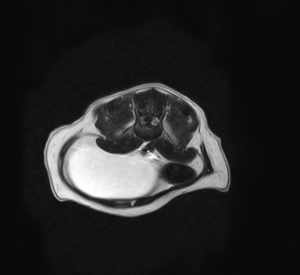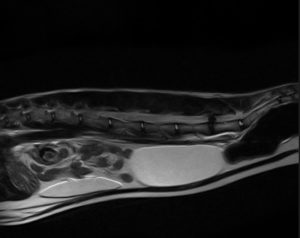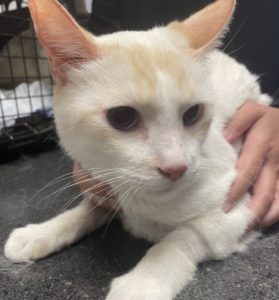Case Study: Loss of Tail Sensation
Presentation and Immediate Care
Stormy, a 7-year-old MN Domestic Short-haired Feline, presented to the VERC Emergency service for difficulty walking. His primary veterinarian had noted that Stormy was unable to feel his tail. On examination, it was confirmed that Stormy had absent tail sensation and a large urinary bladder. It was suspected that Stormy had intervertebral disc disease (IVDD) causing his clinical signs as cats are more likely to have lumbar IVDD. MRI confirmed that Stormy had a large L6-7 disc compressing his spinal cord. Unfortunately, Stormy’s prognosis was guarded due to his loss of tail sensation. This meant that even with surgery, Stormy may experience urinary incontinence and never regain tail sensation. Stormy’s owners were dedicated to giving him a chance and he underwent surgery and a urinary catheter was placed to help with his bladder atony (loss of muscle tone).


Treatments
Post-operatively, Stormy was started on medications to assist with urination in addition to the typical pain medications and anti-inflammatories. Prazosin is a medication to help decrease urinary sphincter tone, making it easier for Stormy to urinate. Bethanechol is a medication that increases bladder contractility, which would help his bladder atony. We also taught his owners to express his bladder. In cases of bladder atony, it is important to help the bladder maintain a small size. If the bladder is too large, the muscular layer will stretch too thin and bladder contraction may never return.
post-op rechek
Recently, Stormy underwent his 1-month post-op recheck. His owners say that he never required bladder expression at home and we confirmed return of tail sensation and movement. His owners say that Stormy can lift his tail up high at home without issue. Stormy did have some residual neurologic signs with some muscle loss in his right pelvic limb and a “dropped-hock” but overall, he is doing great!
Don’t Forget The Tail!
During my residency training at Cornell University Hospital for Animals, one of my mentors – Dr. Emma Davies – would always remind us to check the tail when we were evaluating cats. Her point was that the tail is often forgotten or overlooked during the neurologic exam and cats in the hospital may be less expressive with their tail than dogs. Due to the anatomical differences in dogs and cats, the feline spinal cord often ends in the sacrum while dogs’ typically end in the mid-lumbar spine. When dogs and cats experience injuries in their lumbosacral areas, they can experience issues with incontinence, loss of tail sensation, and difficulty rising or walking. However, it is more likely that a cat may present with absent tail sensation and no other neurologic changes while a dog will typically be more equally affected in the back legs and tail.
When pets lose sensation in their limbs or tail, that is considered a neurologic emergency. Because cats may present with only loss of tail sensation, it is important to remember – Don’t forget the Tail.

